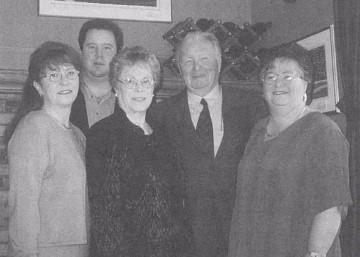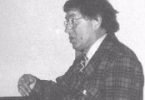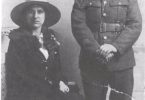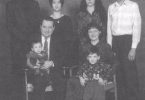I arrived in the Bow Valley in March of 1949, having transferred from line crew (Calgary Power Ltd.), and located at Seebe to begin a long career in the Hydro Plants.
The home where I grew up was located southeast of Lethbridge. I had all my schooling in the area plus two years at Tech (SAIT) in Calgary.
To get into Seebe we had to cross the top of the Dam and, if the hatch covers were off, it proved interesting to straddle the openings for the stop logs. Staffhouse accommodation for the first few months was a duplex – one side for the cook and meals with the other side for bedrooms. With the opening of the new staffhouse building – it meant individual rooms with a large lounge area and recreation rooms. The first shift was evenings – 4 PM to 11 PM in the Kananaskis plant and the introduction to the duties of the floorman. Eventually it would include time at Horseshoe plant before qualifying for an operating position. Thus would begin many years of shift work, the old tin lunch box on a leather strap was a part of the Wardrobe!
I had the opportunity to visit and meet many of the area ranches – including Kananaskis Ranch – The Brewsters, Rafter Six – the Guinns, and the Diamond Cross – Starkey’s (the present site of the Y.M.C.A camp).
I first met Audrey in the summer of 1948, at the time the line crew was building a steel tower line into Calgary. We were married on August 30th of 1950 and honeymooned to the West Coast by car. On our return we took up residence in a three room suite, the upper story of the Cement House near Horseshoe Plant. Heat was by a coal stove, briquettes from Canmore mines. Cooking and lights electrical – naturally. Our first taste of Seebe hospitality to newlyweds – our bed was dismantled and the pieces scattered about the storage area under the eaves. We, in turn, would participate in many such “chivarees”. Wonderful community spirit and frequent parties were held in the hall and school. As seniority was the guideline, each move in Seebe hopefully bettered your level of housing. With the arrival of Patricia in July of 1951, we were still with coal and wood stoves and outdoor facilities. That fall was a time spent at Spray plant during the run-up of the new generator and then a move to Ghost plant for just short of a year, a smaller but close-knit community which included area families with whom we still maintain contact. Our return to Seebe in 1952 and the Control Center, first as an operator and eventually as a supervisor. With the arrival of Leanne in 1954, we were finally into duplex and full facilities including a gas furnace. Quite a start for a city girl – banking coal stoves for overnight, wringer washer, and trying to keep clothes on the line during the frequent winds that blew and blew and blew. A line of clothes in the mud of the garden was a wake up call for an electric dryer.
Both girls took their schooling at Seebe with junior high in Exshaw and high school in Banff. Allan, who was born in 1969, also started in Seebe but our move to Canmore in 1978 meant his schooling would be completed here.
With an interest in education and the preservation of the one-room school, Audrey became a board member, which continued after our move to Canmore, resulting in over twenty years as a trustee.
Curling was a big winter activity in Seebe for all ages. Bonspiels would take us to many community rinks and in Audrey’s case, a trip to the Provincials in Medicine Hat – by train. With a growing family, the rounds of Girl Guides, swimming, music lessons and skiing would occupy many hours of our time. With Allan, it was hockey, basketball and golf. I always said that we wore out a car for each of our children as many activities required driving and, in many case, over long distances to meet a busy schedule.
Shopping initially was done at the Seebe store but we were not long in taking advantage of Naglers in Calgary. A telephone call to place an order and meet the train the next day. Our first experience with Canmore would have been shopping at the Mine Store. Entertainment was movies at the log Opera House. Church in Canmore would also include teas and socials in the old Y.M.C.A. building.
Access to Seebe was the 1A Highway as there was no Trans Canada until later. There were up to five passenger trains daily. Being a whistle stop meant holding up the flags in daylight to stop the train and at night using the lanterns. Bus service was also available both morning and evening. The completion of the Trans Canada Highway through the Rogers Pass was significant as it opened up direct travel to B.C. This helped lead to the demise of our passenger rail service. Transcontinental truck service also became more commonplace.
The term volunteer was not in universal use in our earlier days in the valley as it was more a shared and cooperative system. Whether it was cleaning and flooding the outdoor rink, or any of the many activities that went on, there were jobs to be done and everyone did their share. Once in Canmore, there were similar requirements, but, being a much larger community (population 2,000), it became more of a volunteer way of life. School Board, minor hockey, Community Housing, Heritage Fair, Highland Games and church activities were all areas where we were involved.
The 1988 Olympics were a unique experience, giving the opportunity to meet athletes from around the world, including dignitaries and officials. Both Patricia and I drove during that time and Audrey, being in a gift shop, was also in a position to experience the excitement as well. The effect the Olympics had on Canmore is very evident in the tremendous growth since that time, certainly putting Canmore on the map! The legacy for Canmore is not only the excellent facilities left behind, but also a reputation of being able to host major events very successfully. The Nordic Center has certainly been a tremendous asset as many major world class events have been staged here.
With retirement in January of 1989 it meant more time for golf, bowling and travel. A journey to Great Britain was an opportunity to trace our roots in Guernsey, England and Scotland. Audrey has membership in the Southern Alberta Pioneers, due to her ancestors being in Alberta prior to 1890. This led to a two year term on the Board in Calgary.
The political scene also included being on the Board of Directors for both Provincial and Federal parties. It also led to opportunities to drive for the Premiers’ Conference in Kananaskis Country and the N.A.F.T.A. Conference in Lake Louise. I have had long association with I.B.E.W., as member, Unit Chair and member of the Executive Board in Calgary.
We have been blessed with three children and four grandchildren and still live in our original Canmore home. We were fortunate to obtain the property through lot draw whenAlberta Housing gave the opportunity to participate to residents of the Bow Valley.The location was on land which was used as the original Golf Course, complete with sand greens and rail lines to the mines which crossed the fairways. The steam engine (Old Goat) and coal cars were a natural part of the hazards of playing there.
We have been fortunate in the many friendships we have made. The memories and experiences re-affirm our intention that this is where we wish to continue to live.

Al Petrie family l. to r. Trish Pelletier, Allan Petrie, Jr., Audrey, Al Sr., Leanna Bateman

Al Petrie and grandchildren l. to r. Darren Bateman, Barbara Bateman, Al, Audrey, Christopher Pelletier, Nicole Pelletier
Canmore Seniors at the Summit, ed. Canmore Seniors Association, 2000, p. 221-23







